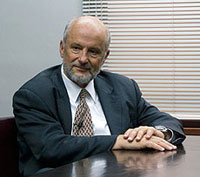APS “April Meeting”
 |
|
Fermilab Director Pier Oddone
|
The traditional April meeting of the American Physical Society is taking place in Anaheim, CA. It began on April 30 and will conclude on May 3. Several APS divisions participate in this meeting: Particles and Fields, Nuclear Physics, Astrophysics, Physics of Beams, Plasma Physics and Computational Physics. This is the principal annual meeting for our discipline. I gave a talk on the “Tevatron and Beyond” and participated in a panel discussion on policy together with several prominent members of the community, the former DOE Associate Director for High Energy Physics Dennis Kovar and the Associate Director of Science at the White House Office of Science and Technology Policy Carl Wieman.
It is a special time for particle physics, with a number of hints that perhaps presage some great new discoveries, but not one of them is yet anything we would call a definitive result. The Tevatron is concluding its career with new records in luminosity and a series of new measurements that show deviations from the physics we would predict from our current knowledge. If some of these hints are confirmed with the data we will collect through the end of this fiscal year, the Tevatron will have yielded more spectacular results in its fantastic career. Lyn Evans, in his talk at the APS on colliders, praised the luminosity achieved by the Tevatron saying that he would have never believed that it would be possible to achieve such luminosity with antiprotons, particles that have to be made, captured, stored, cooled and collided in a very complex process.
The LHC proton-proton collision program has now surpassed the instantaneous luminosity of the Tevatron by a factor of two. The LHC is making rapid and impressive progress. For the time being they have re-discovered the Standard Model and set new limits in a variety of processes, beyond those established by the Tevatron. The blogosphere has lit up with rumors of new physics several times without confirmation. The events are coming fast and furious and the possibility of new discoveries is in the air. It should also be an exciting couple of years at the LHC.
There are also hints of new physics in the neutrino sector, where the differences in neutrino and antineutrino oscillation parameters, if finally made definitive, would again open unexpected domains. At the cosmic frontier, the annual modulation of putative dark matter particles as the Earth moves around the sun, first claimed by the DAMA collaboration, is now joined by hints of such modulation from the CoGeNT detector in Soudan for signals corresponding low-mass dark matter particles close to the detector threshold. Dark matter experiments like Xenon and CDMS would exclude the observations made by CoGeNT and DAMA, provided that their sensitivity is correctly modeled, something that has led to heated discussions in the field.
All of these “almost discoveries” should be resolved in the near future, making for very exciting times ahead.
|